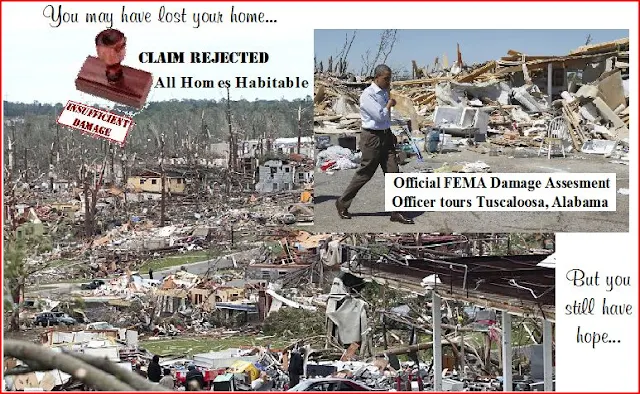Oh now I get it...Katrina was a big, big, big storm...and this was just a little ole tornado.
Broken Bible Belt: Homes in Ruins From Tornadoes Denied Aid by FEMA for ‘Insufficient Damage’ Source: The Blaze
Jefferson County resident Jonathan Stewart said he laughed in shock after the Federal Emergency Management Agency (FEMA) claimed the house his family lost in the deadly April 27 twister was ‘not unsafe to live in’.
Displaced families in tornado-ravaged Alabama are outraged after being denied federal aide to rebuild their flattened homes – due to ‘insufficient damage’.
The devastating reality is the house is now a concrete slab surrounded by rubble.
Mr Stewart told AL.com a FEMA inspector saw first-hand the Pleasant Grove residence he shared with his wife, Lisa, and their two children was ripped from the ground.
Three days after the visit, however, he received a letter reading: ‘Based on your FEMA inspection, we have determined that the disaster has not caused your home to be unsafe to live in.
‘Although the disaster may have caused some minor damage it is reasonable to expect you or your landlord to make these repairs. At this time you are not eligible for FEMA housing assistance.’
Mr Stewart told the website: ‘Lisa and I looked at the letter and laughed.’
While he has since found out his insurance coverage will replace his house, the family is not alone.
Lashunta Tabb’s home 15 miles away in North Smithfield Manor was stripped of its siding, and more than half of her roof blew off with tornado-force winds.
She too, received a letter claiming there was ‘insufficient damage’ – the number one reason in Alabama the people are determined ineligible for FEMA grants, worth up to $30,200.
It is not yet known how many Alabama tornado victims received the letter.
FEMA deputy branch director for individual assistance Lynda Lowe said finding of insifficient damage are often correct, and many of those who filed for assistance did not have damage.
FEMA officials encourage whose who believe they were wrongly declared ineligible to file for an appeal through local disaster recovery centres.
Spokesman Renee Bafalis said: ‘If you have a question why you received a determination of ineligibility, go in there and let them look it up and help you file an appeal.’
A report issued on Wednesday, however, revealed few disaster victims follow through.
It showed less than one percent of the 25,081 applicants initially declared ineligible for any reason had appealed, leaving the potential for millions of dollars in federal aide to go unclaimed.
An applicant has 60 days from the date of the determination letter to appeal.
It was not known at press time how many applicants were declared ineligible in Alabama due to insufficient damage. However, similar findings have occurred after nearly every recent disaster.
THE BUREAUCRACY BEHIND APPLYING FOR FEMA AIDE:
When a disaster victim applies for a FEMA grant, an inspector is dispatched to the applicant’s property.
Inspectors carry laptops connected to a database called NEMIS (National Emergency Management Information System), which guides them through measuring rooms and assessing damage.
Items marked for repair or replacement are priced depending on the geographic region.
Letters are issued based on the computerised report, telling an applicant whether he qualifies for FEMA assistance.
An applicant has 60 days from the date of the determination letter to appeal.
What qualifies as ‘insufficient damage’ remains unclear.
A pending lawsuit accusing FEMA of improperly denying thousands of farm workers in Texas money to repair their homes after Hurricane Dolly struck in 2008 based on the insufficient damage finding claims that FEMA used a concept called ‘deferred maintenance’ to back the rejections.
Deferred maintenance is not referenced in any regulation, Jerry Wesevich, an attorney with Texas Rio Grande Legal Aid who represents the plaintiffs, told AL.com.
Mr Wesevich described deferred maintenance as a ‘shorthand term that FEMA uses when it determines somehow that a condition of a home prior to the disaster caused the damage after the storm’.
An Alabama inspectors’ coordinator for FEMA said deferred maintenance is no longer used in assessing damage, although there is a place for inspectors to note ‘pre-existing’ conditions.
More at the Daily Mail


2 comments:
I hope you don't mind, but am stealing this for tomorrow's posting at Monkey in the Middle.
With a big Hat Tip and link back to you of cause.
I don't mind a bit...any way to spread the word about this pig turd is fine with me...
Post a Comment